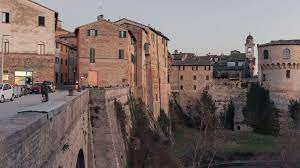Italy: Unusual vegetable ritual

Katie McKnoulty
Rome: Since the Middle Ages, “onion oracles” have been using the root vegetable as a form of divination to peer into the future and predict the weather.
Every year on the evening of 24 January in the central Italian town of Urbania, local schoolteacher Emanuela Forlini cuts a yellow onion into quarters. She then separates out 12 wedges that will form the basis of her local weather predictions for the year ahead. She lays out a slice for each month of the year on her kitchen chopping board, the first representing January, the second February and so on through December.
Sprinkling each piece with a generous pinch of salt, she leaves the board on her windowsill, facing east, and goes to bed. As the first rays of sun appear on the 25th, with her notebook and pen in hand, she interprets each sacred slice, looking for signs supposedly sent by a saint in the salt’s reaction with the onion – are the wedges wet or dry, the salt caked or dissolved? From this, she creates her annual weather forecast for another year, published in local newspapers and on television for the people of Urbania and the surrounding province of Pesaro and Urbino, who await the results with bated breath.

Forlini has been practising this ritual for the past 28 years, carrying on the tradition from her father Anselmo, a lawyer, after he passed away. Her grandfather, Domenico, passed it on to him before that. While Italy is home to a handful of other onion readers, Forlini has become the country’s go-to expert, often featured in regional and national media throughout the years, essentially making Urbania the spiritual home of this tradition. She creates the forecast every year, not out of a strong belief in her own predictions, or even their esoteric nature, but out of duty.
Every evening on 24 January, Forlini leaves the onion wedges by an open windowsill (Credit: Katie McKnoulty)
Every evening on 24 January, Forlini leaves the onion wedges by an open windowsill (Credit: Katie McKnoulty)
“I practice this ritual out of affection for my father and my grandfather, who practiced this tradition. And for me, this means simply keeping alive a very ancient and true tradition that dates back to the Middle Ages but is, above all, a family tradition.”
From reading runes and tea leaves to examining the stars, people throughout history have been looking for signs that might tell them the future, searching for comfort in knowing which way to go. These various modes of divination have taken many different forms depending on the religious, economic and environmental context.
In medieval Europe, many people turned to whatever vegetables were available at the time to predict the weather for the year ahead. In Italy, this vegetable has historically been the common onion, a humble crop readily available to every farming family. Inside Urbania’s 15th-Century Palazzo Ducale, which was commissioned by the Duke of Montefeltro, a library houses the duke’s biography, which dates to the Middle Ages. The book describes his army winning a battle because he had consulted the onions and learned of the bad weather predicted, while his opponents had not.
The practice has more commonly been used by farmers, passed down through generations of those dependent on agriculture. It was essential knowledge – when to plough the earth, plant the seeds, prune and harvest the crops. Failing to consult the onions could mean the difference between feeding your family or not.
People in Urbania have been using onions to predict the weather since the Middle Ages (Credit: Katie McKnoulty)
People in Urbania have been using onions to predict the weather since the Middle Ages (Credit: Katie McKnoulty)
“Up until the first post-war period, it was a thing people believed in and many did it,” Forlini recalled. “Then at a certain point, instead there were people who cultivated this tradition and the farmers turned to these trusted people… among these was my grandfather, who was a farmer that continued this tradition, even later when it had fallen into disuse.”
Urbania resident Anna Damiani remembers a time before smartphones and scientific weather predictions. “Once upon a time, we didn’t have weather forecasts like there are today. So, we always trusted in the things of nature. For example, it was enough that if on a particular day, it rained, for us it meant it would rain for the next 40 days, too. It’s just a belief. Sometimes it worked, but we still continued to believe in it even if sometimes it was also wrong.”
Italy’s few remaining onion oracles tend to be scattered in the country’s central and northern regions, such as the nearby coastal city of Ancona, and farther north in Brescia, Parma and Trento. Their predictions are published in local newspapers including a regional edition of the newspaper Il Resto del Carlino, as well as on a regional TV news programme, the typical refrain being: “The onions have spoken for another year.” The continued annual broadcast of the results helps keep the tradition alive.
In Urbania, the onion weather predictions (il barometro delle cipolle) remain a part of the local lexicon. “Around the town we still hear, ‘The onions have predicted rain!’ or ‘The onions have predicted such and such’,” said Damiani.
Each year, people in Urbania and the surrounding province await the results of the onions with bated breath (Credit: Katie McKnoulty)
Each year, people in Urbania and the surrounding province await the results of the onions with bated breath (Credit: Katie McKnoulty)
According to Forlini, the accuracy of the predictions isn’t what’s important; what matters is that it continues. “We all know that it is not a scientific method, and that for weather forecasting, there are meteorologists and satellites and everything that today’s modern world gives us. It is only a tradition… just a way to keep yourself a little anchored to the past in an emotional way.”
Elisa Luzi is an anthropologist at the University of Tübingen in Germany but hails from a town close to Urbania, and she has been known locally as “the onion girl” ever since writing her bachelor’s thesis at the University of Bologna on the topic of the Urbania onions in 2007. She credits Forlini’s dedication, as well as local farmers who relied on the predictions, for keeping the tradition alive.
“My grandfather was a farmer, so for him it was kind of important. The day that the journal would print the predictions, we’d have to buy the paper and read what happened. He was still attached to this kind of old tradition – following the Moon to know when you have to work the field, when you have to plant, when you have to kill the pigs.”
Chop a medium onion into quarters and place 12 of the largest pieces on a wooden chopping board in two parallel rows. The top row represents January to June, the bottom represents July to December. Sprinkle a generous pinch of fine, non-iodised salt on each slice and leave the board on a windowsill facing east with the window open. At dawn, bring your board inside and analyse your onions straight away.
The top of each slice represents the first 10 days of each month, the middle the second 10 days and the bottom the third portion. Undissolved salt means dry and sunny; melted salt means rain, possibly snow for a winter month; slices hardened with salt crystals mean frost and/or snow; bubbles mean humidity.
The timing of the ritual is rooted in Catholicism, which is intrinsically tied to Italian culture. “Traditionally in the Catholic Church, the day of [January] 25th is the day of the Conversion of St Paul. So, you do it [the ritual] the night before because, like everything, it’s the night before that’s important,” Luzi said.
On the night of 24 January, according to Catholic tradition, Paul received clear signs to become a Christian. This same night was chosen as the best time to read the onions as it was believed to hold some kind of magic. “They thought ‘he was given signs so he’ll give signs to me’,” said Luzi.
While the tradition has Catholicism in its DNA, the Catholic church does not officially support the practice. “They do not condone this kind of stuff. They say, ‘When you pray, you pray to the saints, not to the onions’,” Luzi said.
Onion-reading may no longer serve as practical a role as it once did, but Urbania’s residents are still keen to preserve it. “It’s kind of a point of pride… [it’s] part of what we are, a little piece of our identity that we bring from the past, to the present, to the future,” Luzi said. “Sometimes, you need to remember that you’re a part of history. That it’s not just you.”
When Forlini is finished with her readings, she types them up and sends them to the media for publication. For 2023, the onions predicted a long and cold winter; a spring that starts and finishes with rain, interrupted by a mild and beautiful May in between; a sweltering summer; a mild early autumn that lasts until the end of October; and an earlier-than-usual start to a cold winter. After all is said and done, she puts the onions to good use. “I certainly don’t throw them away!” she said. “Along with other onions, I’ll make onion soup for the evening.”





